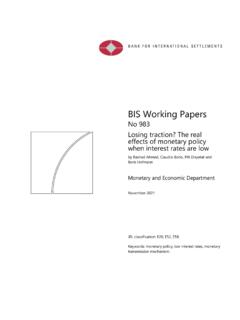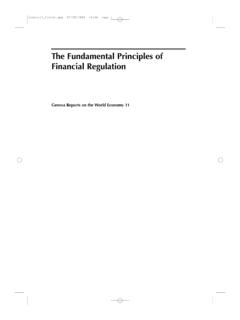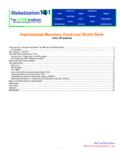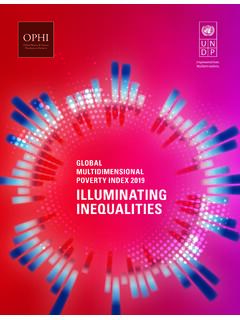Transcription of Digital currencies and the future of the monetary system
1 1/17 Digital currencies and the future of the monetary system Remarks by Agust n Carstens1 General Manager, Bank for international Settlements Hoover Institution policy seminar Basel 27 January 2021 Introduction It is a great pleasure to be here today. Thank you to John Taylor and John Cochrane for the invitation. It is an honour to speak to this select group of Hoover Institution affiliates, Stanford faculty and Stanford students who are surely the policymakers, entrepreneurs and innovators of tomorrow. In my remarks today, I will address the digitisation of Does the economy need Digital currencies ? Digital money itself is not new. Commercial bank money has been Digital for decades, and we already use Digital means of payment on a daily basis.
2 Central banks already provide wholesale Digital money to banks. In today s lecture, though, I would like to discuss new forms of Digital currencies or Digital cash that have been in the news lately, including central bank Digital currencies , or CBDCs. If we need Digital currencies of these new kinds, who should issue them, and how should they be designed? What are the implications of Digital currencies for the monetary system ? These are weighty issues that are much on the minds of central bankers, scholars and the general public. Today I hope to clarify the concepts and sketch a path for the way forward. 1. Do we need new Digital currencies ? If so, who should issue them? Let s start with whether the economy needs Digital currencies , and from whom. It is stating the obvious that our economy is in the middle of a technological A combination of new Digital technologies and greater online activity allows huge volumes of data to be 1 I would like to thank Raphael Auer, Jon Frost, Leonardo Gambacorta and Hyun Song Shin for support in preparing this speech, and Morten Bech, Sarah Bell, Stijn Claessens, Emma Claggett and Tara Rice for providing comments.
3 I thank Giulio Cornelli for research assistance. 2 Digitisation refers to the process of changing information from analogue to Digital form. In the context of money, this refers to creating a Digital representation of money, or moving it to Digital form. Digitalisation , meanwhile, refers to the use of Digital technologies to change a business model and provide new revenue and value-producing opportunities, or the process of moving to a Digital business. See Gartner, Gartner Glossary, 2021, accessed 15 January 2021. 3 F Caselli, Technological revolutions , American Economic Review, vol 89, no 1, 1999 defines a technological revolution simply as the introduction of a new type of machines that are more productive than machines of the pre-existing type . T Kuhn, The structure of scientific revolutions, University of Chicago Press, 1962 discusses the related notion of scientific revolutions, when, in the accumulation of new knowledge, anomalies lead to a sudden paradigm shift or change in beliefs.
4 K Schwab, The fourth 2/17 collected, managed and telecommunicated. This has dramatically lowered the costs of many It has resulted in powerful, hyper-scalable applications that have disrupted entire industries everything from taxis to print media. New players have entered the Digital economy to provide these services. While advances in information technology and communications have been under way for many decades, the past decade has ushered in truly far-reaching changes. The Covid-19 pandemic may have further accelerated the pace of Digital The technological revolution has also reached the financial system and even the design of money itself. Just to name one example, on primary foreign exchange (FX) venues, market-makers can now access real-time prices at five-millisecond time intervals.
5 Project Rio, a new application for monitoring fast-paced markets developed at the BIS Innovation Hub, allows the entire market order book to be monitored every 100 milliseconds, or 36,000 times every The first point of entry into finance is the market for payment services, which are foundational to all economic Payments are attractive for Digital disrupters because they are relatively less capital-intensive than other financial services, and the information they generate is highly valuable for cross-selling. Perhaps it is no surprise that we ve seen a burst of Digital innovation in payments, including new Digital payment offerings by fintech startups, big techs and Many payment innovations build on improvements to underlying infrastructures that have been many years in the making.
6 For instance, harnessing technological progress, central banks around the world have instituted real-time gross settlement (RTGS) systems over the past decades. Meanwhile, operating hours of these systems have continued to lengthen around the globe, and in several countries are already operating almost 24/7. Also on the retail side, innovation is rampant, and a growing number of economies 51 by our last count have fast retail payment systems, which allow 24/7 instant settlement of payments between households and businesses (Graph 1). These include systems like the Unified Payment Interface (UPI) in India, CoDi in Mexico, PIX in Brazil and the FedNow proposal in the US. Together, these innovations have shown that the existing system can adapt, providing good examples of how innovation in public-private partnerships is working.
7 Industrial revolution: what it means, how to respond , Foreign Affairs, December 2015 discusses the unique features of the fourth industrial revolution, which involves a fusion of technologies that is blurring the lines between the physical, Digital , and biological spheres . 4 For an overview, see A Goldfarb and C Tucker, Digital economics , Journal of Economic Literature, vol 57, no 1, 2019. 5 To name just one example, the pandemic has led to a surge in e-commerce, particularly in countries with stricter lockdown measures and where e-commerce was previously less developed. See V Alfonso, C Boar, J Frost, L Gambacorta and J Liu, E-commerce in the pandemic and beyond , BIS Bulletin, no 36, 2021.
8 6 Project Rio is being developed in the BIS Innovation Hub s Switzerland Centre, together with the Swiss National Bank. See BIS, BIS Innovation Hub sets out annual work programme and launches Innovation Network , press release, 22 January 2021; and A Carstens, Central bank innovation from Switzerland to the world , speech at the founding ceremony of the BIS Innovation Hub Swiss Centre, Zurich, 8 October 2019. 7 See BIS, Central banks and payments in the Digital era , Annual Economic Report 2020, June 2020, Chapter III. 8 See M Bech and J Hancock, Innovations in payments , BIS Quarterly Review, March 2020. 3/17 Diffusion of retail fast payment systems1 Number of countries Graph 1 1 The dotted part of the lines corresponds to projected implementation.
9 Source: BIS, Central banks and payments in the Digital era , Annual Economic Report 2020, June 2020, Chapter III . Yet no one is compelled to choose the path of the existing monetary system . In addition to improvements to existing systems, many attempts to innovate in less traditional fields have been unleashed. One example is Digital currencies which could transcend both traditional account-based money and physical cash. As already mentioned, account-based money has been Digital for decades, as electronic deposits on a Digital ledger. Yet there have been calls and attempts to digitise all money, including In my view, fully replacing either bank accounts or cash is neither desirable nor realistic, but let us discuss what a further digitisation of money could look like.
10 Narayana Kocherlakota one of the world s leading monetary theorists, former president of the Federal Reserve Bank of Minneapolis and a former Stanford professor argued in a famous 1998 paper that money is memory . By substituting for an otherwise complex web of bilateral IOUs, money is a substitute for a publicly available and freely accessible device that records who owes what to The idea that money is the economy s memory leads us to two forks in the road for the design of Digital money (Graph 2). At these junctions, decisions about architecture and access need to be taken. First, it needs to be ensured that the memory is always and everywhere correct. In payments parlance, this means ensuring the integrity and safety of the payment system , as well as the finality of payments.













